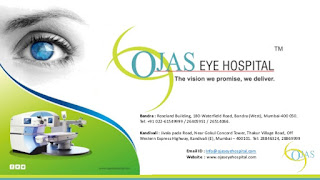Types Of Ophthalmic Surgeries at ojas eye hospital in Mumbai
Introduction
The eye has different parts and each part is vital for imparting proper vision. Each part has different sets of functions and thus have different effects on vision. Some parts, such as retina, cornea, and lens are essential for vision. Various surgical options are available to treat disorders related to the eyes.
Retinal Surgeries
- Pneumatic Retinopexy: Pneumatic surgery is a non-incisional process which is used in the treatment of retinal detachment. In this procedure, the ophthalmic surgeon inserts a gas bubble in the middle part of the eye. The gas bubble floats on the detached area and presses them against detachment. After this process, the surgeon will close the open part of the retina with the help of a laser beam and freezing probe. To have the best surgery done for retinal disorders, the patient should consult a Retina Specialist in Mumbai.
- Pars Plana Vitrectomy: It is a surgical process which removes and replaces the vitreous humor or gel of the eye. In this technique, the surgeon will make an incision on the outer membrane of the eye and insert a vitrectomy probe for cutting the vitreous humor and remove the broken part of fluid by using a suction tool.
- Scleral Buckle: Scleral buckle is a surgical process which is used for the treatment of various type of retinal detachment. This process is used to close breaks and flattening the retina. In this surgery, the surgeon will place scleral buckle at the outer part of the eye (sclera) and leave it for a lifetime. A scleral buckle is a small piece of rubber, silicone sponge and semi-hard plastic.
Corneal Surgeries
- Deep Anterior Lamellar Keratoplasty (DALK): It is a surgical technique which is used for removal of the corneal stroma, located in between the corneal substance keeping the patient’s Descemet membrane and endothelium intact. This technique is generally used in corneal transplantation. In this technique, the surgeon injects a large bubble of air in the stroma and remove stroma by using a Devers dissector. A graft is placed for filling the space between posterior stroma and Descemet membrane and are secured through running sutures.
- Corneal Inlays: A corneal inlay is a surgical process, used for the treatment of presbyopia. Presbyopia is a disease in which the vision for a near object is decreased because of the reduced capacity of the lens in changing its shape. In this technique, a laser beam is used to cut a small flap at the mid part of non-dominant eye’s cornea. Then the inlay is inserted into the flap. Corneal inlays help in reducing the dependency on reading glasses.
- Corneal cross-Linking process: This process is used for straightening the cornea. It is a minimally invasive process. In this process, the surgeon uses ultraviolet light and eye drop for straightening the collagen fiber of cornea. This process is used in patients with keratoconus in which cornea become thin and weak.
Refractive Surgeries
- Radial Keratotomy (RK): It is the oldest and successful technique which is performed for the treatment of myopia. In myopia, the distance object appears blurry. In this process, the surgeon will make a deep incision by using a diamond blade. Unlike laser surgery, the surgeon reshapes the cornea through a deep incision.
- Laser-assisted in situ Keratomileusis (LASIK): This is a laser refractive type surgery. LASIK surgery is performed to treat myopia, hyperopia, and astigmatism. In this procedure, a special type of cutting laser is used to reshape the cornea. In this process, the surgeon will make a flap on the cornea. The flap exposes the corneal tissue and replaces them after reshaping the cornea.
- Photorefractive Keratectomy (PRK): It is also a laser refractive type surgery which is used to treat nearsighted, farsighted and astigmatism. In this technique, the thin outer layer of the cornea, called an epithelial layer, is removed for reshaping the underlying tissue through an excimer laser or exciplex laser.
Surgeries For Glaucoma
- Trabeculectomy: It is a procedure which is used for the treatment of glaucoma by decreasing the intraocular pressure form eye. In this technique, the surgeon will make a small cut in the eyewall or sclera. The small cut will help to drain out excess fluid from the eye.
- Iridectomy: Iridectomy is a procedure which is used to treat glaucoma and iris melanoma. Iris is a colored and circular membrane which is located at the back of the cornea. In this technique, the surgeon creates a small hole in the iris by using a laser. This hole assists in moving the aqueous humor from the posterior chamber to the anterior chamber of the eye.
- Goniotomy: It is the surgery used to treat glaucoma and is considered as minimally invasive surgery. In this surgery, the surgeon makes an opening in the trabecular meshwork. The trabecular meshwork is a group of the small canal which is responsible for aqueous humor drainage. The new opening of the eye provides a way to drain the fluid from the eye.

Comments
Post a Comment